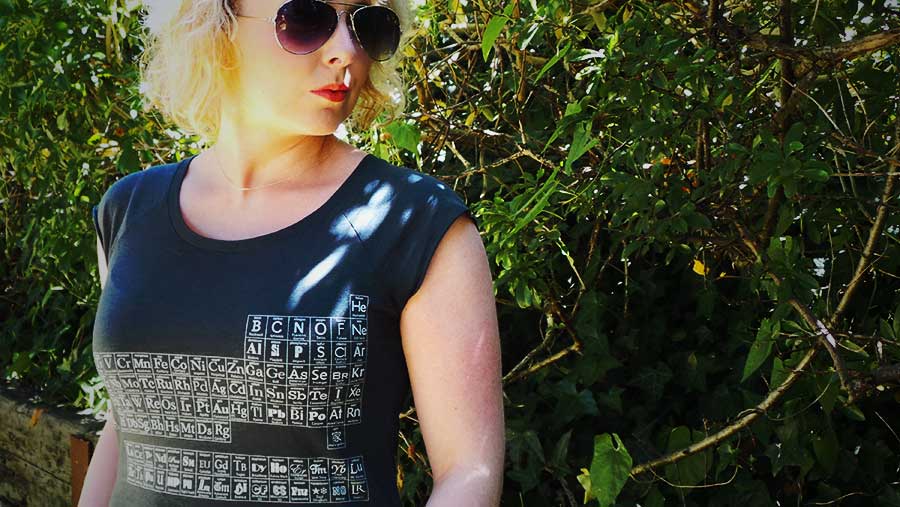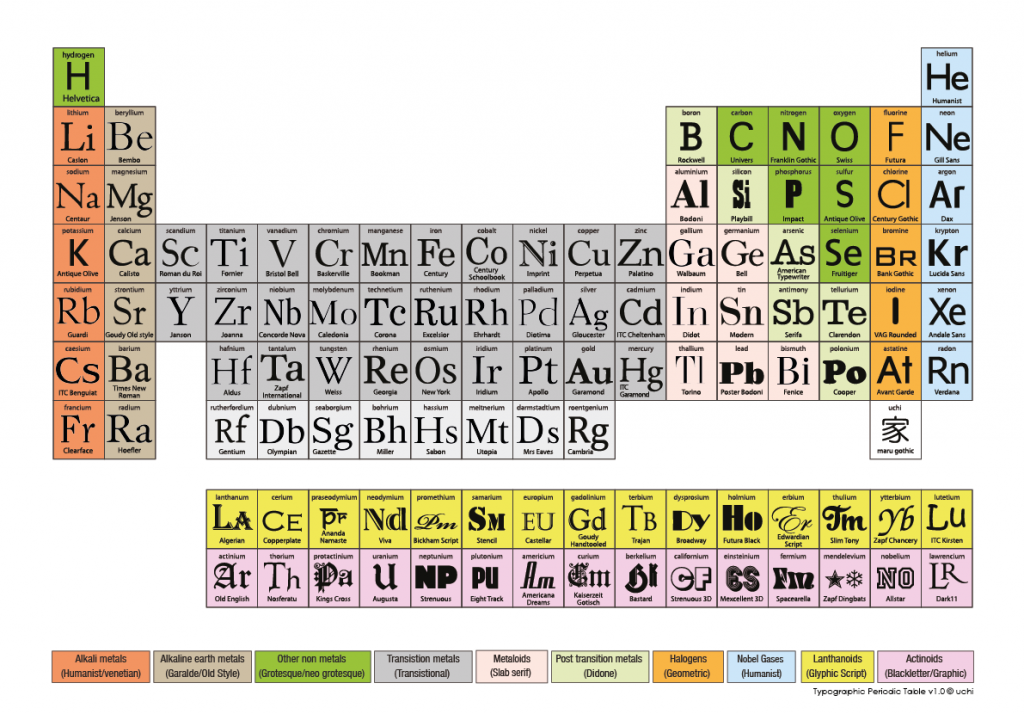
Jul 2, 2015 | T shirts, Typography
By popular request, here’s the first colour drop of uchi’s Typographic Periodic Table – charcoal grey on a women’s bamboo T shirt.

There’s quite a few “Periodic Table of Typefaces” T shirts and posters but uchi’s version is not just a Periodic Table of Typefaces for typography geeks done in the ‘style’ of the Periodic Table. uchi’s Typographic Periodic Table uses the actual Periodic Table of Elements, containing both elements and typefaces for chemistry geeks and typography geeks alike. In my opinion, there’s no point in displaying typefaces using such an iconic (and useful) format just because it looks good, without trying, at least, to do justice to both the Periodic Table and typography. Plus I love both science and typography, so had to put the work in…

Typographic Periodic Table of Elements
uchi’s Periodic Table — a brief description of each typeface group.
 There are many styles of type and many classification systems – defined by their visual characteristics (stroke contrast, serif shape, etc) and their historical development or reference. Here, I’ve tried to match typefaces over the ages into their main classifications within the element groups on the Periodic Table. Also, except for the Lanthanoids and Actinoids (Glyphic, Script, Blackletter and Graphic faces) and, where possible, in each element group, the typefaces are in roughly in date order from the top to bottom. There are some notable exceptions for aesthetic reasons. For example, Helevtica was made in 1957, but it had to be Hydrogen!
There are many styles of type and many classification systems – defined by their visual characteristics (stroke contrast, serif shape, etc) and their historical development or reference. Here, I’ve tried to match typefaces over the ages into their main classifications within the element groups on the Periodic Table. Also, except for the Lanthanoids and Actinoids (Glyphic, Script, Blackletter and Graphic faces) and, where possible, in each element group, the typefaces are in roughly in date order from the top to bottom. There are some notable exceptions for aesthetic reasons. For example, Helevtica was made in 1957, but it had to be Hydrogen!
Want to know your serif from your slab-serif? Read on for a brief description of each type style.
(more…)

Jan 21, 2015 | Design, T shirts
The golden section is also referred to as the golden ratio, golden spiral, golden mean and divine proportion. It is a ratio approximately equal to 1.618. Represented by the Greek letter phi (Φ), not to be confused with Pi, it is sometimes thought to be the most pleasing shape to the eye.

Golden ratio Mens T shirt – – White
Think of any two numbers. Make a third by adding the first and second, a fourth by adding the second and third, and so on. When you have written down about 20 numbers, calculate the ratio of the last to the second from last. The answer should be close to 1.61803399. The Fibonacci sequence follows this ratio.
(more…)

 There are many styles of type and many classification systems – defined by their visual characteristics (stroke contrast, serif shape, etc) and their historical development or reference. Here, I’ve tried to match typefaces over the ages into their main classifications within the element groups on the Periodic Table. Also, except for the Lanthanoids and Actinoids (Glyphic, Script, Blackletter and Graphic faces) and, where possible, in each element group, the typefaces are in roughly in date order from the top to bottom. There are some notable exceptions for aesthetic reasons. For example, Helevtica was made in 1957, but it had to be Hydrogen!
There are many styles of type and many classification systems – defined by their visual characteristics (stroke contrast, serif shape, etc) and their historical development or reference. Here, I’ve tried to match typefaces over the ages into their main classifications within the element groups on the Periodic Table. Also, except for the Lanthanoids and Actinoids (Glyphic, Script, Blackletter and Graphic faces) and, where possible, in each element group, the typefaces are in roughly in date order from the top to bottom. There are some notable exceptions for aesthetic reasons. For example, Helevtica was made in 1957, but it had to be Hydrogen!



